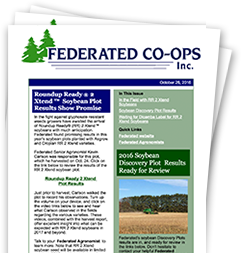Fall Ag Lime Offers Good ROI

Ag lime is “one of your cheapest fertility tools,” said Matt Kurtz, manager of Federated’s Rush City location. “It’s one of the most cost-effective fertilizer tools,” and when it’s applied in the fall when trucking costs are at their lowest, it’s the proverbial win-win.
Soybeans are coming off the fields with “a lot better yields than expected,” said Kurtz, and thanks to the good fall weather, there’s still plenty of time to get into harvested fields and easily take soil samples, which “will tell us whether or not we need lime application.”
Assumptions about crop nutrient removal aren’t a good basis for fertilizer choices.
“You may need just lime and not all the other nutrients,” said Kurtz, but there’s no way to know that without the soil samples. (Grid sampling can especially help address highly variable pH levels.)
Given the high prices on crop inputs and only so many dollars to invest in the crop, “it’s important to put the correct [fertilizer] product(s) on the field,” Kurtz noted. The soil samples will help “put the dollars in the right place.”
“Ag lime is very important to maximize soil fertility,” he said. Optimized pH along with the magnesium found in ag lime can boost yields. Your Federated Agronomist will “come up with the proper recommendation,” said Kurtz. “You can put too much on sandy ground … heavier ground may need more.”
The best time for Federated’s custom ag lime applications is in December, January, and February when fall fertilizer is done and fields won’t be “ripped up” with the application.
“It’s one of those things definitely worth looking at,” said Kurtz. Talk to your Federated Agronomist for soil sampling and ag lime recommendations.


